|
|
|
Sort Order |
|
|
|
Items / Page
|
|
|
|
|
|
|
| Srl | Item |
| 1 |
ID:
082428
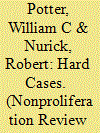

|
|
|
|
|
| Publication |
2008.
|
| Summary/Abstract |
Many countries received Soviet-origin highly enriched uranium (HEU) for civilian nuclear research purposes. Because of inadequate nuclear security at a number of the research sites, U.S. policy has sought to remove or otherwise safely dispose of their HEU stocks as quickly as possible. Although the pace of HEU disposition has accelerated significantly in recent years, several sites have posed formidable technical, economic, and political challenges. This article identifies the major obstacles to HEU removal at two key installations-Kharkiv in Ukraine, and Sosny in Belarus-and recommends a strategy for overcoming these impediments. Key components for a successful disposition strategy include: treating these cases with the urgency they deserve, expanding potential compensation packages, explicitly addressing the institutional and political issues involved, engaging high-level political leaders, working with third parties, and promoting these efforts as part of a nondiscriminatory initiative to phase out HEU in the civilian nuclear sector globally.
|
|
|
|
|
|
|
|
|
|
|
|
|
|
|
|
| 2 |
ID:
082429
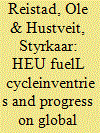

|
|
|
|
|
| Publication |
2008.
|
| Summary/Abstract |
In 2007, 334 nuclear reactors (including for naval propulsion) and isotope production facilities employed highly enriched uranium (HEU) fuel or target material. One year of operations at these reactors and facilities required more than 3,100 kilograms (kg) of HEU for naval propulsion, more than 750 kg for research reactors, and 40?-50 kg for isotope production in civilian facilities-in addition to several tons used in other types of reactors. Material with high enrichment levels and low radiation barriers stored or handled in large batches, such as HEU target waste and certain types of fuel from isotope production, research reactors/critical assemblies, and naval fuel, presents serious safety and security concerns. Forty-eight civilian research reactors have converted to low-enriched uranium as a result of a three-decade international effort to minimize HEU use, resulting in a decrease in HEU consumption of 278 kg per year. This article's establishment of baseline measurements for assessing the results of HEU minimization efforts calls for additional focus on the scope and methodology of HEU minimization. Facility decommissioning and dismantling should play a larger role in the future HEU minimization effort, materials with specific weapons-relevant properties should be given higher priority compared to bulk HEU material, and the use of large quantities of weapon-grade HEU fuel for naval propulsion should be reconsidered.
|
|
|
|
|
|
|
|
|
|
|
|
|
|
|
|
| 3 |
ID:
082425
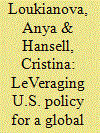

|
|
|
|
|
| Publication |
2008.
|
| Summary/Abstract |
.S. leadership has been the driving force behind reducing the civilian use of highly enriched uranium (HEU). By tracing the history of linkages between U.S. HEU policies at home and abroad, this paper examines the reasons why the U.S.-led Reduced Enrichment for Research and Test Reactors (RERTR) and HEU removal programs, despite great technical successes, have not led to quicker elimination of weapon-grade uranium. It argues that the United States must take urgent steps domestically and internationally in order to achieve global elimination of the use of HEU in the civilian sphere. Washington must restore consistency of HEU policy by rescinding the Burr Amendment and consider reductions in the U.S. military stockpile as a means of signaling its commitment. U.S. leaders must also find more creative ways to engage countries and individual facilities in HEU minimization and to extend the norm against HEU use worldwide
|
|
|
|
|
|
|
|
|
|
|
|
|
|
|
|
| 4 |
ID:
082426
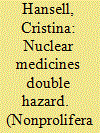

|
|
|
|
|
| Publication |
2008.
|
| Summary/Abstract |
This article examines the production of metastable technetium-99 (Tc-99m), the world's most important radiopharmaceutical, focusing on reliability of supply and risks of nuclear terrorism. Only four producers manufactured about 95 percent of the world's Tc-99m; a closure of any of them could cause worldwide shortfalls. Moreover, all four employ highly enriched uranium in their production process, in a form relatively easy to convert into the metal needed for a nuclear bomb. The technology to employ low-enriched uranium (LEU)-not usable in weapons-to produce Tc-99m is proven, available, and has been used by smaller producers. However, political determination and sufficient funding are needed to convert the major producers' isotope production to LEU and encourage new LEU-based production. Such efforts are needed to ensure supplies and reduce security risks.
|
|
|
|
|
|
|
|
|
|
|
|
|
|
|
|
| 5 |
ID:
082424
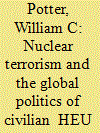

|
|
|
|
|
| Publication |
2008.
|
| Summary/Abstract |
An increasing number of countries recognize the special risks of nuclear terrorism associated with the civilian use and storage of and commerce in highly enriched uranium (HEU). They are especially concerned that non-state actors might gain access to HEU and use it to build and detonate improvised nuclear devices. The risk is aggravated by the very large global stocks of HEU, some of which are inadequately protected. Although HEU has few commercial uses, and most experts believe it is technically feasible to substitute low-enriched uranium for HEU in nearly all civilian applications, efforts to reduce HEU stocks have been impeded by a variety of economic, political, and strategic considerations. This article analyzes the nature of these impediments and discusses what is required to overcome them
|
|
|
|
|
|
|
|
|
|
|
|
|
|
|
|
| 6 |
ID:
082427
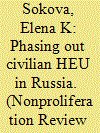

|
|
|
|
|
| Publication |
2008.
|
| Summary/Abstract |
Russia holds the largest stocks of civilian highly enriched uranium (HEU) of any country, operating more than fifty research reactors, pulsed reactors, and critical assemblies using HEU, as well as nine HEU-fueled icebreakers. Russia's participation in international efforts to phase out civilian HEU is crucial if international HEU minimization efforts are to succeed. Individual Russian institutes and organizations participate in international programs to replace HEU with low-enriched uranium in Soviet-supplied research reactors, develop alternative fuels, and repatriate fresh and spent HEU fuel from third countries. However, an overarching national policy on HEU phase-out has yet to be adopted. There are many obstacles to obtaining such a commitment from Moscow. At the same time, the ongoing reform of the Russian nuclear industry and plans for expansion of domestic nuclear power generation and for increased nuclear exports create opportunities for securing such a commitment
|
|
|
|
|
|
|
|
|
|
|
|
|
|
|
|
| 7 |
ID:
082430
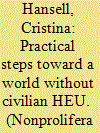

|
|
|
|
|
| Publication |
2008.
|
| Summary/Abstract |
In the last three decades, the Reduced Enrichment Research and Test Reactors program has made great progress in developing the technical means to eliminate HEU use in most civilian applications. Yet in practice, this has not translated into significant global reductions in HEU use. This article identifies steps to build the international consensus needed to reduce the risks posed by HEU. Immediate steps include devising new incentives for reactor shutdown and conversion; establishing research reactor coalitions; launching a global HEU database; giving the International Atomic Energy Agency a mandate to promote HEU minimization; and improving physical protection standards. Intermediate measures include the adoption of HEU management guidelines and a code of conduct. Further, national governments should pass laws phasing out domestic use of HEU and conditioning HEU exports on conversion commitments. In the long term, international legal measures must be adopted to eliminate the risks posed by HEU.
|
|
|
|
|
|
|
|
|
|
|
|
|
|
|
|
| 8 |
ID:
082433
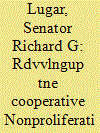

|
|
|
|
|
| Publication |
2008.
|
| Summary/Abstract |
In its sixteen years of existence, the Nunn-Lugar program has successfully dismantled nuclear, biological, and chemical weapons in the former Soviet Union. Washington's periodic disagreements with Russia should not halt this critical work. Moreover, the United States must expand the Nunn-Lugar principles to new regions of world and to new types of threats. It is particularly vital to give Nunn-Lugar the authority to work with countries under conditions where U.S. legal obstacles might otherwise bar such cooperation, and to eliminate red tape and bureaucratic burdens on the Defense Threat Reduction Agency so it can respond to unforeseen contingencies. For example, Nunn-Lugar already has destroyed a chemical weapons stockpile in Albania, and it should be given the flexibility to work in North Korea if a future agreement makes that possible. Nunn-Lugar should be expanded so the United States can work cooperatively to control stockpiles of conventional weapons, train foreign governments in the interdiction of dangerous weapons and materials, and assist in responding to attacks involving weapons of mass destruction
|
|
|
|
|
|
|
|
|
|
|
|
|
|
|
|
| 9 |
ID:
082434


|
|
|
|
|
| Publication |
2008.
|
| Summary/Abstract |
Based on the first-person account of coauthor Pierre Billaud, a prominent French participant, this article describes for the first time in such detail the history of the development of the French hydrogen bomb in the 1960s and the organization of military nuclear research in France. The authors illustrate the extent to which French defense and governmental authorities did not support research on thermonuclear weapons until 1966. Billaud, a project insider, relates the historical episodes that led to France's successful 1968 thermonuclear test, including the names of the individuals involved and how a timely tip from a foreign source hastened the success of the first H-bomb test.
|
|
|
|
|
|
|
|
|
|
|
|
|
|
|
|
| 10 |
ID:
082431


|
|
|
|
|
| Publication |
2008.
|
| Summary/Abstract |
This article explores the challenges that Australia faces in reconciling its commitments to nonproliferation and uranium exports during a time when the international nuclear nonproliferation regime is under major stress and the world uranium market is bullish. The “grand bargain” that has framed Australian participation in the nonproliferation regime and the nuclear fuel market since the 1970s was only tenable in an era of stagnant uranium demand and a stable nuclear balance. However, contemporary nuclear proliferation dynamics and the revival of interest in nuclear energy have accentuated the incompatibility between Australia's commitment to nonproliferation and the desire to profit from uranium exports. The contemporary international strategic environment, international nonproliferation regime, and nuclear energy market are characterized by developments that not only undermine the basis of Australia's grand bargain, but also present challenges and opportunities for the refashioning of Australian policy.
|
|
|
|
|
|
|
|
|
|
|
|
|
|
|
|
| 11 |
ID:
082435


|
|
|
|
|
| Publication |
2008.
|
| Summary/Abstract |
This article explores the challenges of implementing UN Security Council Resolution 1540 through the prism of the "tragedy of the commons." Because implementing 1540 requires a significant investment of time and resources, the decision by states not to implement the resolution is a rational inaction for each individual state driven by self-interest to maximize private gains. However, this ultimately leads to collective irrationality and the destruction of the public good, i.e., common security, leaving every state worse off.
|
|
|
|
|
|
|
|
|
|
|
|
|
|
|
|
| 12 |
ID:
082432


|
|
|
|
|
| Publication |
2008.
|
| Summary/Abstract |
In discussing China's January 2007 hit-to-kill intercept of the Chinese weather satellite FengYun-1C, most American analysts sought the "message" for the United States-either by asserting that China's test was a deliberate step toward a comprehensive counterspace capability to offset U.S. conventional military superiority or an attempt to force the United States to the negotiating table on "the prevention of an arms race in outer space." Chinese officials, after a long silence, eventually claimed the test was an "experiment" that was "not targeted at any country." We traveled to China several times in 2007 and had a series of conversations with Chinese individuals knowledgeable about the history of this particular antisatellite program and with access to information about the decision-making process prior to and after the final test. These discussions were off the record, not for attribution, given the sensitivity of the subject. They reflected the views of some of the key institutions involved in the test from the State, the Communist Party, the People's Liberation Army, and aerospace experts involved in debris calculations. The information conveyed to us suggests that American commentators tend to place much greater importance on the United States as a driver in China's decision to develop the technology and conduct the test than do the Chinese.
|
|
|
|
|
|
|
|
|
|
|
|
|
|
|
|
|
|
|
|
|